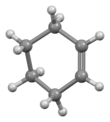Cyclohexene
| |||
| |||
| Names | |||
|---|---|---|---|
| Preferred IUPAC name
Cyclohexene | |||
| Other names
Tetrahydrobenzene, 1,2,3,4-Tetrahydrobenzene, Benzenetetrahydride, Cyclohex-1-ene, Hexanaphthylene, UN 2256
| |||
| Identifiers | |||
3D model (JSmol)
|
|||
| 906737 | |||
| ChEBI | |||
| ChEMBL | |||
| ChemSpider | |||
| ECHA InfoCard | 100.003.462 | ||
| EC Number |
| ||
| 1659 | |||
PubChem CID
|
|||
| RTECS number |
| ||
| UNII | |||
CompTox Dashboard (EPA)
|
|||
| |||
| |||
| Properties | |||
| C6H10 | |||
| Molar mass | 82.143 g/mol | ||
| Appearance | colorless liquid | ||
| Odor | sweet | ||
| Density | 0.8110 g/cm3 | ||
| Melting point | −103.5 °C (−154.3 °F; 169.7 K) | ||
| Boiling point | 82.98 °C (181.36 °F; 356.13 K) | ||
| slightly soluble in water | |||
| Solubility | miscible with organic solvents | ||
| Vapor pressure | 8.93 kPa (20 °C)
11.9 kPa (25 °C) | ||
Henry's law
constant (kH) |
0.022 mol·kg−1·bar−1 | ||
| -57.5·10−6 cm3/mol | |||
Refractive index (nD)
|
1.4465 | ||
| Hazards | |||
| GHS labelling: | |||
    
| |||
| Danger | |||
| H225, H302, H305, H311, H411 | |||
| P210, P233, P240, P241, P242, P243, P264, P270, P273, P280, P301+P310, P301+P312, P302+P352, P303+P361+P353, P312, P322, P330, P331, P361, P363, P370+P378, P391, P403+P235, P405, P501 | |||
| NFPA 704 (fire diamond) | |||
| Flash point | −12 °C (10 °F; 261 K) | ||
| 244 °C (471 °F; 517 K) | |||
| Explosive limits | 0.8–5 % | ||
| Lethal dose or concentration (LD, LC): | |||
LD50 (median dose)
|
1407 mg/kg (oral, rat) | ||
LCLo (lowest published)
|
13,196 ppm (mouse, 2 hr)[2] | ||
| NIOSH (US health exposure limits): | |||
PEL (Permissible)
|
TWA 300 ppm (1015 mg/m3)[1] | ||
REL (Recommended)
|
TWA 300 ppm (1015 mg/m3)[1] | ||
IDLH (Immediate danger)
|
2000 ppm[1] | ||
| Safety data sheet (SDS) | External MSDS | ||
Except where otherwise noted, data are given for materials in their standard state (at 25 °C [77 °F], 100 kPa).
| |||
Cyclohexene is a hydrocarbon with the formula (CH2)4C2H2. It is an example of a cycloalkene. At room temperature, cyclohexene is a colorless liquid with a sharp odor. Among its uses, it is an intermediate in the commercial synthesis of nylon.[3]
Production and uses
[edit]Cyclohexene is produced by the partial hydrogenation of benzene, a process developed by the Asahi Chemical company.[4] The main product of the process is cyclohexane because cyclohexene is more easily hydrogenated than benzene.
In the laboratory, it can be prepared by dehydration of cyclohexanol.[5]
- C6H11OH → C6H10 + H2O
Reactions and uses
[edit]Benzene is converted to cyclohexylbenzene by acid-catalyzed alkylation with cyclohexene.[6] Cyclohexylbenzene is a precursor to both phenol and cyclohexanone.[7]
Hydration of cyclohexene gives cyclohexanol, which can be dehydrogenated to give cyclohexanone, a precursor to caprolactam.[8]
The oxidative cleavage of cyclohexene gives adipic acid. Hydrogen peroxide is used as the oxidant in the presence of a tungsten catalyst.[9]
1,5-Hexadiene is produced by ethenolysis of cyclohexene. Bromination gives 1,2-dibromocyclohexane.[10]
Structure
[edit]Cyclohexene is most stable in a half-chair conformation,[11] unlike the preference for a chair form of cyclohexane. One basis for the cyclohexane conformational preference for a chair is that it allows each bond of the ring to adopt a staggered conformation. For cyclohexene, however, the alkene is planar, equivalent to an eclipsed conformation at that bond.
See also
[edit]References
[edit]- ^ a b c NIOSH Pocket Guide to Chemical Hazards. "#0167". National Institute for Occupational Safety and Health (NIOSH).
- ^ "Cyclohexene". Immediately Dangerous to Life or Health Concentrations (IDLH). National Institute for Occupational Safety and Health (NIOSH).
- ^ Xie, Feng; Chen, Lihang; Cedeño Morales, Eder Moisés; Ullah, Saif; Fu, Yiwen; Thonhauser, Timo; Tan, Kui; Bao, Zongbi; Li, Jing (2024). "Complete separation of benzene-cyclohexene-cyclohexane mixtures via temperature-dependent molecular sieving by a flexible chain-like coordination polymer". Nature Communications. 15 (1): 2240. Bibcode:2024NatCo..15.2240X. doi:10.1038/s41467-024-46556-6. PMC 10933443. PMID 38472202.
- ^ US 9771313, Narisawa, Naoki & Tanaka, Katsutoshi, "Cyclohexanol, method for producing cyclohexanol, and method for producing adipic acid", published 26 Sep 2017
- ^ G. H. Coleman, H. F. Johnstone (1925). "Cyclohexene". Organic Syntheses. 5: 33. doi:10.15227/orgsyn.005.0033.
- ^ B. B. Corson, V. N. Ipatieff (1939). "Cyclohexylbenzene". Organic Syntheses. 19: 36. doi:10.15227/orgsyn.019.0036.
- ^ Plotkin, Jeffrey S. (2016-03-21). "What's New in Phenol Production?". American Chemical Society. Archived from the original on 2019-10-27. Retrieved 2018-01-02.
- ^ Musser, Michael T. (2005). "Cyclohexanol and Cyclohexanone". Ullmann's Encyclopedia of Industrial Chemistry. Weinheim: Wiley-VCH. doi:10.1002/14356007.a08_217. ISBN 978-3-527-30673-2.
- ^ Reed, Scott M.; Hutchison, James E. (2000). "Green Chemistry in the Organic Teaching Laboratory: An Environmentally Benign Synthesis of Adipic Acid". J. Chem. Educ. 77 (12): 1627–1629. Bibcode:2000JChEd..77.1627R. doi:10.1021/ed077p1627.
- ^ H. R. Snyder, L. A. Brooks (1932). "1,2-Dibromocyclohexane". Organic Syntheses. 12: 26. doi:10.15227/orgsyn.012.0026.
- ^ Jensen, Frederick R.; Bushweller, C. Hackett (1969). "Conformational preferences and interconversion barriers in cyclohexene and derivatives". J. Am. Chem. Soc. 91 (21): 5774–5782. doi:10.1021/ja01049a013.
External links
[edit]- International Chemical Safety Card 1054
- NIOSH Pocket Guide to Chemical Hazards. "#0167". National Institute for Occupational Safety and Health (NIOSH).
- Material Safety Data Sheet for cyclohexene
- Safety MSDS data
- Reaction of Cyclohexene with Bromine and Potassium Permanganate
- Cyclohexene synthesis
- Data sheet at inchem.org





